Earlier American Bank Note Company notes
The American Bank Note Company records the following print runs.
| Date | Value | Number | Series | from | to |
| December 1881 | 25c | 200,000 |
200001 | 400000 | |
| 50c | 150,000 |
150001 | 300000 | ||
| $1 | 175,000 |
175001 | 350000 |
 The National Bank Note Company was taken over by the American Bank Note Company in 1879 and the latter used the early plates for a further print run in December 1881ABNC. The new designs for the 25c, 50c and $1 with the contraseña were approved on 30 December 1881 and a printing of 25c notes in November 1887, but altered them by adding a contraseña, a small 2 in a circle. On the 25c this symbol is at the end of Maceyra's signature: on the 50c it is before and after the phrase 'AL PORTADOR' and on the $1 it is above both the series letter. The 25c has larger numbers than on the first issue, and some are also seen with no numbers as the last 52,576 were delivered to the bank without numbering. It seems that for the $1, the numbering started with Serie F thus:
The National Bank Note Company was taken over by the American Bank Note Company in 1879 and the latter used the early plates for a further print run in December 1881ABNC. The new designs for the 25c, 50c and $1 with the contraseña were approved on 30 December 1881 and a printing of 25c notes in November 1887, but altered them by adding a contraseña, a small 2 in a circle. On the 25c this symbol is at the end of Maceyra's signature: on the 50c it is before and after the phrase 'AL PORTADOR' and on the $1 it is above both the series letter. The 25c has larger numbers than on the first issue, and some are also seen with no numbers as the last 52,576 were delivered to the bank without numbering. It seems that for the $1, the numbering started with Serie F thus:
| A 5, 17, ... | B 11, 23, ... |
| C 6, 18, ... | D 12, 24, ... |
| E 7, 19, ... | F 1, 13, ... |
| G 8, 20, ... | H 2, 14, ... |
| I 9, 21, ... | J 3, 15, ... |
| K 10, 22, ... | L 4, 16, ... |
On 26 December 1881 a Mexican newspaper reported a monetary crisis (crisis monetaria) in Paso del Norte (Ciudad Juárez) caused by a combination of an abundance of Banco Mexicano notes and a lack of silver coinsEl Siglo Diez y Nueve, 26 December 1881. Had the new notes driven out the silver coinage, forcing merchants to accept them against their will?.
On 4 July 1883 an additional issue of 300,000 pesos in notes of one, two, five, ten and twenty pesos, payable in hard cash (en pesos fuertesthe notes themselves bear the legend en moneda de plata del cuño mejicano), was authorised. These, like other banknotes authorised after this date, had to carry the signature of the Administrador General de Rentas or some mark to show that they had been recorded in a book in his officePeriódico Oficial, 14 July 1883. These had already been ordered from the American Bank Note CompanyOne $1 face plate and one $1 back plate (6 notes on each) and one $1 tint plate (1 note) made on order on 5 June 1883.
One $2 face plate and one $2 back plate (4 notes on each) and one $2 tint plate (1 note) made on order on 5 June 1883.
One $5 face plate and one $5 back plate (4 notes on each) and one $5 tint plate (4 notes) made on order on 5 June 1883.
One $10 face plate and one $10 back plate (2 notes on each) and one $10 tint plate (2 notes) made on order on 5 June 1883.
One $20 face plate and one $20 back plate (1 note on each) and one $20 tint plate (1 note) made on order on 5 June 1883.
These were cancelled on 14 March 1932. and dates written on proofs and orders suggest that the notes were actually printed in August 1883.
The notes had stock vignettes from the American Bank Note Company and its predecessor, the National Bank Note Company.
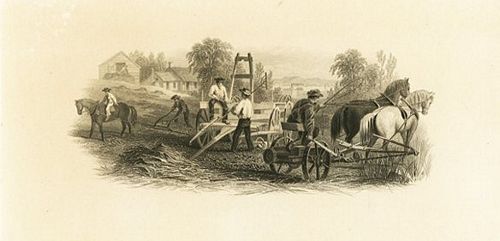
The $1 had a vignette of a ploughing scene (ABNC #684) in the centre. The $2 had a portrait of the goddess Athena (ABNC #452) on the left and a couple of miners(?) (C-93) on the right. The $5 had the NBNC vignette of two horses "Looking out" in the centre with a vignette of a woman (ABNC #140) on the left and a godess (ABNC #216) on the right. The $10 used two NBNC vignettes, “Aguadores” on the left and “Frutera” on the right, whilst the central vignette (ABNC #1101) was of Euthenia(?), the personification of prosperity, abundance and gain, with a corn sheaf and fruit. The $20 had an NBNC vignette “Palm Tree” on the left, and a vignette of peasants around a fountain (C-54) on the right.
The $5 was originally proofed in red, then changed to blue, whilst the $10 was originally proofed in blue, then redone in red.
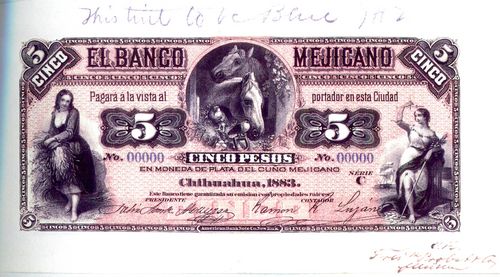 M114p $5 Banco Mejicano proof
M114p $5 Banco Mejicano proof
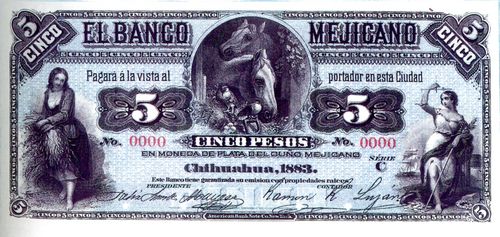 M114p $5 Banco Mejicano proof
M114p $5 Banco Mejicano proof
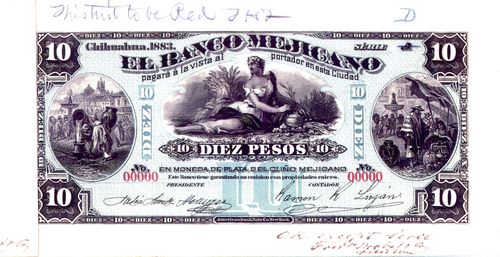 M115p $10 Banco Mejicano proof
M115p $10 Banco Mejicano proof
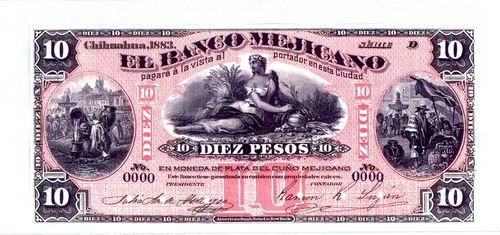 M115p $10 Banco Mejicano proof
M115p $10 Banco Mejicano proof
Again the $10 was originally Series A, but then the five different denominations were given the five different series letters, A to EABNC.
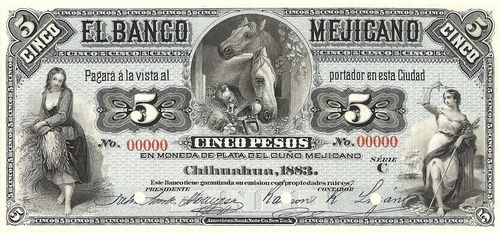
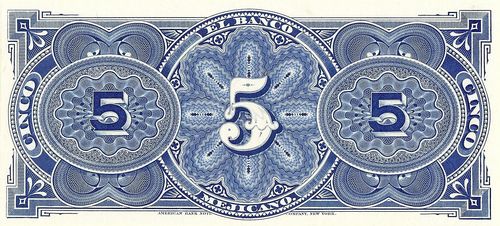 M114s $5 Banco Mejicano specimen
M114s $5 Banco Mejicano specimen
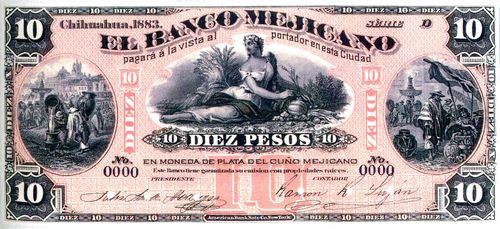
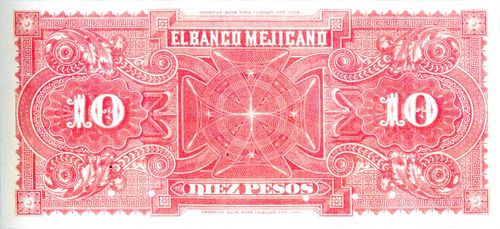 M115s $10 Banco Mejicano specimen
M115s $10 Banco Mejicano specimen
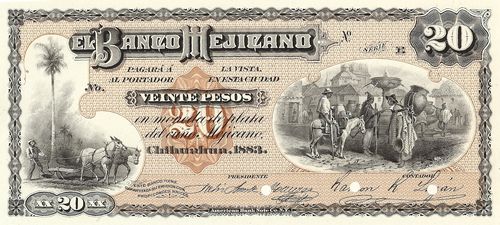
 M116s $20 Banco Mejicano specimen
M116s $20 Banco Mejicano specimen
| Date | Value | Number | Series | from | to |
| June 1883 | $1 | 123,000 |
A | 1 | 123000 |
| $2 | 50,000 |
B | 1 | 50000 | |
| $5 | 21,000 | C | 1 | 21000 | |
| $10 | 7,500 | D | 1 | 7500 | |
| $20 | 1,000 | E | 1 | 1000 |
The $1 order was for 150,000 notes but only 123,000 were delivered.
These notes were put into circulation on 18 September 1883Periódico Oficial, 20 September 1883.
| Date | Value | Number | Series | from | to |
| November 1887 | 25c | 400,000 |
400001 | 747424 |
The final 52,576 were not numbered.
Signatories
The signatories continued to be Félix Francisco Maceyra as President and Ramón Luján as Accountant (Contador).
1884 nickel crisis
In 1884 Mexican President Manuel González attempted to introduce a new nickel coinage but this was immediately rejected by the population. On 14 April there were riots in Chihuahua as shopkeepers refused to accept the coins and since there were no other acceptable low value coins in circulation the general public were unable to purchase essential goods. To deal with the crisis Interim Governor Celso González ordered 4,400 pesos in copper coins from the Secretaría de Hacienda and also granted each of the four banks in Chihuahua permission to issue fractional paper currency in one, five and ten centavos values up to the amount of 5,000 pesosInforme of Governor Celso González, 1 June 1884.
No examples are known from this bank though a contemporary Mexico City newspaper implies that the bank, along with the Banco de Santa Eulalia and the Banco Minero Chihuahuense, did issue such fractional notesEl Tiempo, 19 August 1884. It can be seen (see Notes in Circulation) that the value of notes in circulation includes odd centavos and so suggests that some notes had been issued, though there are also odd centavo amounts in the balance sheet of the second issue.
Newspaper reports of a robbery, 1885
In April 1885 American newspapers reported that a box containing sixty thousand dollars (sic) in unsigned banknotes destined for the bank, stored in the Custom House at Ciudad Juárez, was broken open and robbed of all but a five thousand dollar package. Three customs officials were arrested on suspicion and steps taken to notify all areas of Chihuahua of the robberyLos Angeles Times, 29 April 1885: Salt Lake Herald, 29 April 1885:The Deseret News, 1 May 1885. However, this was a mistake, corrected in later reportsGalveston Daily News, 30 April 1885: it was the Banco Minero Chihuahuense that suffered the lossIt is likely that the newspapers misread the notification (presuming un banco mexicano to be el Banco Mexicano).
‘Billetes de moneda corriente’ and ‘billetes de pesos fuertes’
In November 1884 the American Bank Note Company produced ten electrotypes with the legend "El Banco Mexicano pagará á la vista el valor de este billete en plata á la par. – 1884” (presumably similar to the ones it produced for the Banco de Santa Eulalia).
In 1887 the newspaper El Parral complained about unjust practices at the bank’s branch or agency in Hidalgo del Parral. The Jefe Político of the district investigated and found that the agency only issued Banco Mexicano notes in moneda corriente, and changed them for pesos fuertes at the normal local discount of 9%, and that Banco Mexicano notes in pesos fuertes were only issued by the bank’s head offices in Chihuahua, and could only be redeemed there. The Parral branch had no obligation to exchange these, so when people presented them, the branch did offer notes in moneda corriente but included the 9% premiumPeriódico Oficial, 2 February 1887.
